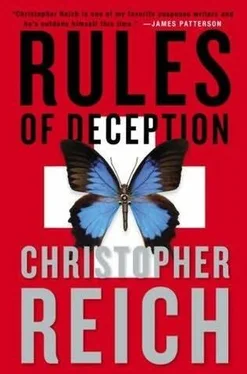Theodoor Albrecht Lammers was born in Rotterdam in 1961. After earning a doctorate in mechanical engineering at Utrecht University, he drifted in and out of jobs at several undistinguished firms in Amsterdam and The Hague. He came to the notice of the authorities in 1987 while working in Brussels as an associate of Gerald Bull, the American armaments designer. At the time, Bull was busy creating a “supergun” for Saddam Hussein. Code-named Babylon, the gun was actually a giant artillery piece capable of lobbing a shell hundreds of miles with deadly accuracy. His work for the Middle Eastern potentate was a matter of public record. All the same, Bull and his associates (Theo Lammers included) were considered “persons of interest” by the Belgian police.
Von Daniken knew the rest of the story himself. Gerald Bull was murdered in 1990, shot five times in the back of the head by an assassin waiting in the foyer of his Brussels apartment. At first, speculation had it that it was the Mossad, Israel’s intelligence service, which had killed him. The speculation was incorrect. At the time, the Israelis had kept up a distant but cordial relationship with the scientist. As prospective clients, they were eager to know exactly what he was up to. It was for this very reason that the Iraqis had killed him. Once the Babylon gun was built, Saddam Hussein did not want Bull sharing its secrets with anyone, especially the Israelis.
Von Daniken closed the e-mail, then stood and walked to the window. The morning was gray and grim, wet snow dropping from lowlying cloud cover. The view gave onto a parking lot, and farther on, a half-finished office tower, crawling with laborers despite the weather.
And Lammers? he asked himself. What had he been up to that warranted keeping an Uzi in his workshop and a variety of passports in his bathroom? Or to necessitate sending a professional killer to lie in wait behind his woodshed?
Von Daniken returned to his desk. Several dossiers lay on top. They were labeled “Airports and Immigration,” “Counterterrorism/Domestic,” “Counterterrorism/Foreign,” and “Trafficking.” He skimmed their contents, saving “Counterterrorism/Foreign” for last.
This dossier contained a summary of wires from foreign security services. In 1971, the chief of the Swiss intelligence service, alarmed by the specter of politically motivated acts of violence, helped establish a confederation of Western European law enforcement professionals charged with ensuring their country’s internal security. The group became known as the Club of Bern. After 9/11, the group formalized their relationship and took the name “Counterterror Group,” or CTG.
The topmost report was from his counterpart in Sweden and stated that Walid Gassan, a suspected extremist (Sweden did not countenance the use of the word “terrorist”) had been spotted in Stockholm. It went on to say that Gassan was deemed a priority suspect in the bombing of the Sheraton Hotel in Amman, Jordan, as well as several failed attacks, and requested that any information regarding Gassan or his accomplices be forwarded to the Swedish intelligence service immediately.
The report was accurate, if incomplete.
Walid Gassan had passed through Switzerland in January. Working off a tip from an informant in Geneva’s “Big Mosque,” von Daniken had sent a team to track him down and arrest him. Though not wanted in Switzerland, the red flag warrant issued by Interpol gave von Daniken the authority to take Gassan into custody. As it turned out, fate had been with Gassan, and the terrorist had slipped across the border before von Daniken could do anything more than issue an alert about his whereabouts. He thought of the fingernail he’d found in the aircraft. Maybe his reports on Gassan’s movements had done some good. He did not know, however, whether the terrorist had been kidnapped off the streets of Stockholm or some other European city. He would leave it to Philip Palumbo, head of the CIA’s Special Removal Unit, to inform the Swedes of Gassan’s current location, if and when he saw fit.
Von Daniken walked downstairs to the second floor, advancing along a cool, gray-carpeted corridor to the last door on the right. “KILA 2.8,” read the room placard.
“KILA” stood for the Coordination Unit for Identity Documents. It was KILA’s job to maintain a collection of identity documents from every country around the world. Somewhere in its compendious cabinets was at least one example of every passport, driver’s license, birth certificate, and any other commonly produced identity document currently in circulation in more than two hundred countries around the world.
Von Daniken stuck his head in the door. “Max, you busy?”
Max Seiler ran KILA. He was a short, barrel-chested man with blue eyes and thinning blond hair. “I thought you’d be in,” he said, looking up from his work. “Heard you had quite a night.”
Von Daniken filled Seiler in on the details. “These turned up in the victim’s house,” he said, tossing the three passports onto the desk.
Seiler examined the documents. “An agent?”
“Agent. Trafficker. Crook. One of the above.”
Seiler focused on a maroon passport with a royal coat of arms and the words “Europese Unie Koninkrijk der Nederlanden” emblazoned on the cover. “This the real one?”
“As far as I can tell, Lammers is his real name. He had a C permit giving his nationality as Dutch. ISIS has him tracked back to a university in the Netherlands. I doubt that he went undercover before he was eighteen. Regardless, I want a thorough check. Run all of them through Identigate, then drill down for the breeder docs.”
Breeder documents included social security cards and birth certificates: the government-issued paperwork that validated one’s identity.
Leaning to his side, Seiler cleared a stack of papers off a nearby chair. A glance revealed Italian driver’s licenses, German medical insurance cards, English birth certificates. All fakes.
“Jules Gaye, born 1962, Brussels,” he read aloud, after opening the Belgian passport. He flipped through the pages, studying the immigration stamps, then returned to the front page and held it under a goosenecked ultraviolet light. A faint image of Belgium’s royal palace came to life.
“Reactive ink looks good,” said von Daniken.
“The new Belgian issues are sharp. This one has five security features to put a crimp in counterfeiting. A laser-cut pinhole of the passport holder, a watermark of Albert II, an optically variable image of Belgium that changes from green to blue depending on the viewing angle, and two microtaggants. Offhand, I’d say it’s genuine.”
“You mean the blank?”
“Not only the blank. I mean ‘genuine’ as in official. Issued by the proper passport authority.”
“You’re sure?” Von Daniken’s skepticism was born of experience. Belgian passports were the VWs of the false documents trade. Cheap, reliable, and easy to come by. Since 1990, over nineteen thousand authentic blanks had been stolen from Belgian consulates, embassies, town halls, and diplomatic pouches the world over. The country lost passports the way some people misplaced their keys.
“We can check.” Logging onto his computer, Seiler fed the passport number into Identigate, the Swiss police’s repository of over two million stolen and fraudulent documents from around the world. “The Belgians are as scrupulous about reporting stolen blanks as they are lax about losing them,” he said. “If it’s stolen, we’ll get a match.” After a moment, his broad features creased in dismay. “Nothing. As far as the Belgians are concerned, it’s legit.”
“You’re sure it hasn’t been tampered with?”
“Positive. The pictures are burned into the fabric of the passport itself. It’s physically impossible for Lammers to have replaced the original holder’s photograph with his own.”
Читать дальше












